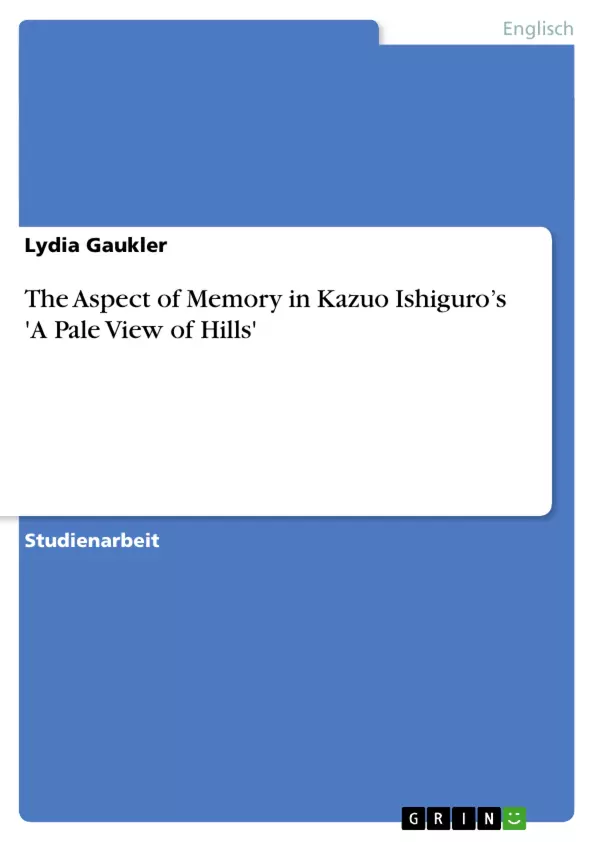It is widely accepted that human memory constitutes identity: We need to have individual memories in order to experience biographical continuity. Without the episodic (or autobiographical) memory, it would be impossible for us to link our individual past to ourselves. The strong connexion between memory and identity is a very prominent topic in contemporary British fiction and the significance of memory is discussed in many literary works. One of this books is Kazuo Ishiguro’s first novel A Pale View of Hills.
In this novel, Kazuo Ishiguro concerns himself with memories and their problematic function in the process of forming one’s identity. All of his novels he has published so far deal with “individuals scanning their past for clues to their identity, loss, or abandonment.” This also applies to A Pale View of Hills. The novel, Childs summarizes, “is a gentle meditation on memory and sublimated pain, which uses fantasy and displacement to reveal indirectly the distress of a woman who has lost her homeland, her husbands, and her elder daughter.”
In the following, I will first outline the plot of the novel. Then I shall want to concentrate on memory as a means to create identity and to avoid responsibility. I shall also discuss the unreliability of the narrator. As we will see, this unreliability enables the reader to decipher the narrator’s memories. At last I shall try to answer the question how the main protagonist in the novel uses his memory to overcome a loss by transferring her guilt onto an imagenary character.
Inhaltsverzeichnis
- 1. Introduction
- 2. The Plot of the Novel
- 3. Etsuko's failure as a mother
- 4. The Unreliability of the Narrator
- 5. The Function of Memory in the Novel
- 6. Conclusion
Zielsetzung und Themenschwerpunkte
Die vorliegende Arbeit befasst sich mit der Rolle von Erinnerung in Kazuo Ishiguros Roman „A Pale View of Hills". Der Fokus liegt dabei auf der Analyse, wie die Erinnerungen der Protagonistin Etsuko sowohl die Konstruktion ihrer Identität beeinflussen als auch zur Vermeidung von Verantwortung dienen. Darüber hinaus wird die Unzuverlässigkeit der Erzählerin untersucht und wie diese dem Leser Einblicke in ihre Erinnerungen ermöglicht.
- Die Bedeutung von Erinnerung für die Identität
- Die Unzuverlässigkeit der Erzählerin
- Die Rolle von Erinnerung in der Bewältigung von Verlust
- Die Verbindung von Erinnerung und Schuld
Zusammenfassung der Kapitel
- Kapitel 1: Introduction: Die Einleitung stellt die Relevanz von Erinnerung für die menschliche Identität dar und führt den Leser in das Thema des Romans ein.
- Kapitel 2: The Plot of the Novel: Dieses Kapitel bietet eine Zusammenfassung der Handlung von „A Pale View of Hills". Es zeigt, wie die Geschichte von Etsukos Begegnung mit ihrer Tochter Niki eingerahmt wird und wie Etsukos Erinnerungen in die Zeit des Nachkriegsjapans zurückführen.
- Kapitel 3: Etsuko's failure as a mother: Dieses Kapitel fokussiert auf Etsukos Rolle als Mutter und ihren Umgang mit dem Tod ihrer Tochter Keiko.
- Kapitel 4: The Unreliability of the Narrator: Dieser Abschnitt beleuchtet die Unzuverlässigkeit der Erzählerin und wie diese dem Leser ermöglicht, ihre Erinnerungen zu entschlüsseln.
- Kapitel 5: The Function of Memory in the Novel: In diesem Kapitel wird die Funktion der Erinnerung in „A Pale View of Hills" untersucht und analysiert, wie die Protagonistin ihre Erinnerung nutzt, um mit Verlust umzugehen.
Schlüsselwörter
Die Arbeit konzentriert sich auf die Themen Erinnerung, Identität, Unzuverlässigkeit der Erzählung, Verlust, Schuld, Nachkriegsjapan, Etsuko, „A Pale View of Hills", Kazuo Ishiguro, biographische Kontinuität, autobiographisches Gedächtnis, und die Verbindung zwischen Erinnerung und Verantwortung.
- Quote paper
- Lydia Gaukler (Author), 2006, The Aspect of Memory in Kazuo Ishiguro’s 'A Pale View of Hills', Munich, GRIN Verlag, https://www.grin.com/document/71528



